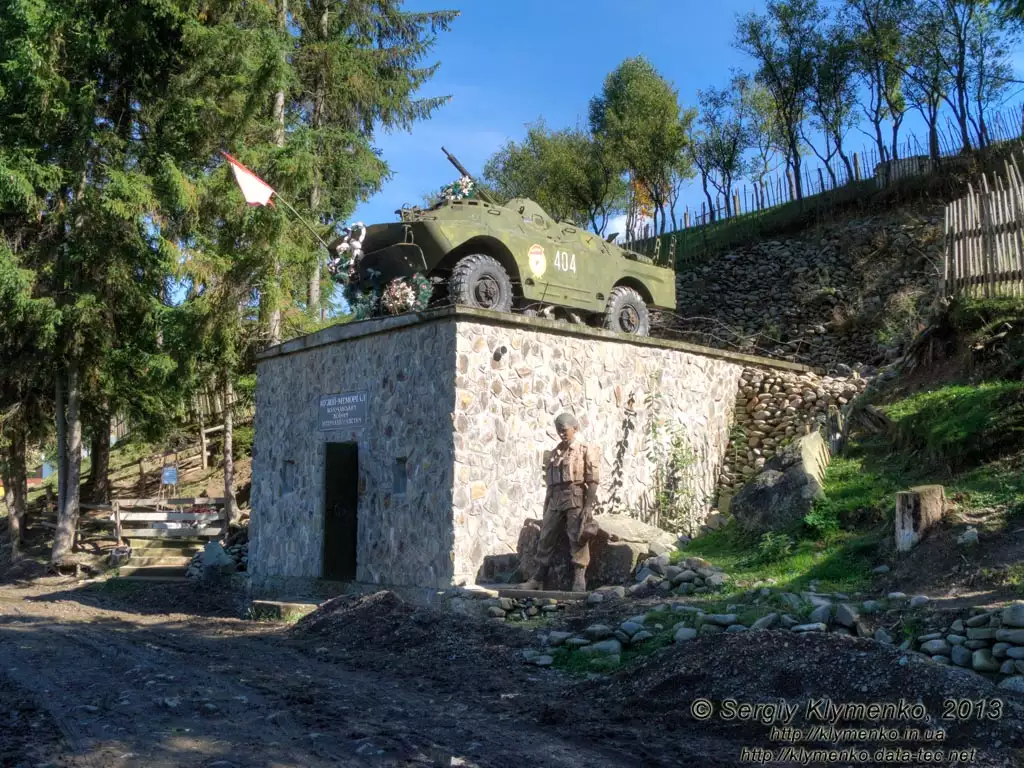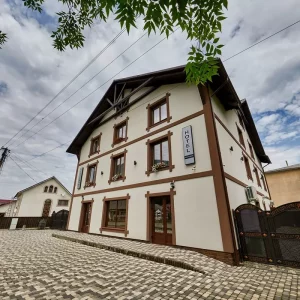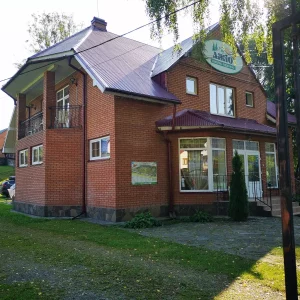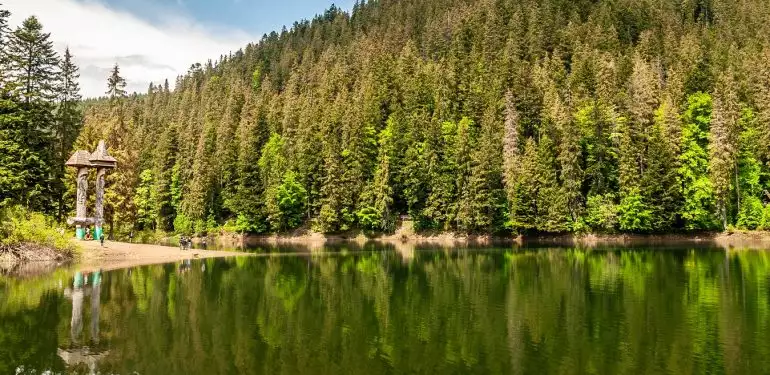Kolochava is a unique mountain village located at an altitude of 631 meters above sea level, in the enlarged Khust district (before the enlargement Mizhhirsky district) of the Transcarpathian region, in the West of Ukraine.
Even ten years ago, it was a very difficult task to come to Kolochava. However, in recent years, local roads have been overhauled, especially in the direction of the city of Khust. Although it is still far from ideal, positive changes are noticeable and bring Kolochava closer to even more tourists.
For people who value comfort, freedom of movement and independence, the most successful way to come to Kolochava is to have their own car. This method is the most convenient if you are traveling in Ukraine and decided to stop by Kolochava for a day or two. Also, if you decide to visit Kolochava in winter for a week or two and go for a drive at the nearby ski resorts, then you will simply need a car.
Kolochava is located 27 km from the village. Mizhgirya and 58 km from the town of Khust (regional center).
The Kolochava – Ust-Chernaya – Bedevlya road (T0728) is marked on the maps of Ukraine, but in reality there is no road on the Kolochava – Ust-Chernaya section and even an all-terrain vehicle will not pass there. Be vigilant and don’t get into an awkward situation when you need to return.
It is better to go from almost any corner of Ukraine to Kolochava through Mizhhirya.
Traveling from the North (Kiev) or the East (Kharkov) of Ukraine, we would recommend going through Lviv. This can be done in two ways. In time, both paths are approximately the same.
The first option is Lviv – Stryi – Dolina – Mizhgirya – Kolochava – 220 kilometers. This path is shorter, but the coverage of the Dolyna – Mizhhirya road section is not in its best form. However, the condition is not critical and you can drive. Moreover, this route is much more beautiful. Traveling for the Christmas holidays, you will pass through the town of Bolekhiv, which is usually incredibly decorated. You will also pass through the Torun Pass (930 meters at sea level), which is very beautiful in summer and even more beautiful in winter. On the other hand, the pass is rather treacherous, and if a lot of snow falls, then you can not drive through it and wait a long time until they clear the way or return.
Therefore, if during the trip you got into heavy snowfalls, or you know that you were yesterday or the day before yesterday, then it is better to go along the second route: Lviv – Stryi – Volovets – Mizhgirya – Kolochava – 249 kilometers. This path is 29 km longer, but this distance compensates for the better condition of the road surface. Also on this route, you will pass a beautiful stretch of a very modern road, reminiscent of the European Autobahn. In addition, the path passes through the Volovetsky Pass.
From Uzhgorod it is best to go along the route Uzhgorod – Mukachevo – Svalyava – Volovets – Mizhgirya – Kolochava – 159 kilometers.
It is better to go from Kiev to Kolochava via Lviv. On the highway Kiev – Zhytomyr – Rivne – Lviv, the road is really European level. The car “floats” along the road like a ship in calm weather: not a single hole, new markings and signs, partial lighting and noise-absorbing fences create the impression that you are abroad. After driving 500 km, you almost never feel tired. You can get from Lviv to Kolochava using one of the two routes already described. The route Kiev – Kolochava through Lviv has a length of 761 km.
Also, from Kiev to Kolochava you can get through Zhitomir – Ternopil – Valley – Mizhhirya. This path is 53 km shorter, the total length is 708 km. However, the poor condition of roads and holes will negatively affect the chassis of the car and tire the driver very much. And you are unlikely to come sooner.
It is better to travel from Kharkov to Kolochava via Kiev and Lvov. The length is 1237 km.
From Odessa to Kolochava you can get on the route Odessa – Uman – Vinnitsa – Khmelnitsky – Ternopil – Dolina – Mizhgirya – Kolochava, 938 km long. Good news – to Uman along the modern road, bad news – from Uman along the “Ukrainian” road.
For people who want to calmly rest among the pure nature for a week or two and do not plan to travel somewhere every day, the most successful one would be to come to Kolochava by train. In Kolochava itself, if you are planning to visit tourist sites nearby, you can always order an inexpensive transfer. But it is easier to go to one of the existing various tourist routes, which may include the whole range of services: transfer, excursion, meals and anything on your order.
Arriving by train is much cheaper. In addition, it is not so tiring: there is more space on the train, you can walk, sleep and you don’t need to sit in one place like in a car. No car or driver required. It is also much safer to travel this way.
However, in Kolochava itself, the train and tracks remained only in the Kolochavskaya Narrow-Gauge Railway Museum. The nearest station is Volovets. You can get to it from any other railway station, including from Kiev, Lvov, Uzhgorod, Kharkov, Odessa.
The schedule changes periodically. You can buy tickets on-line and get more detailed information on the official service of Ukrzaliznytsia – http://booking.uz.gov.ua or directly on the website http://www.uz.gov.ua.
From Volovets to Kolochava (60 km) can be reached by car. Taxi drivers are always on duty at the railway station. But usually tourists order a transfer from the only tour operator in Kolochava “Agio-Tour”. This makes it cheaper and more comfortable. The tourist is sure that he will be met and taken to his destination. Fans of extreme sports and thrills can try to get from Volovets to Kolochava by public transport. Minibuses do not turn to the railway station, so you will need to go to the intersection and stand on the road of Mizhgirya direction (about 150 m from the station).
The public transport schedule is constantly changing, so it is better to check by calling the information desk or find the relevant information on the Internet, for example, on the website http://bus.com.ua.
After analyzing the timetable of regular buses and minibuses, we can conclude that it is extremely inconvenient to travel from Volovets to Kolochava by public transport, especially with suitcases on hand. Besides the fact that such a trip is very tiring and annoying, it will take a very long time. Therefore, we recommend ordering a transfer in advance and without unnecessary worries, you can comfortably get to Kolochava in an hour. Pamper yourself, you are still on vacation …
It is interesting to visit Kolochava at any time of the year. It is worth stopping by in winter to feel the atmosphere of traditional Christmas. In spring, in Kolochava, you can admire the real purple sea – here is the saffron valley. In summer, you should visit the Riplyanka Festival and try your hand at the Shepherd’s School. Autumn is the best time to explore the museums of Kolochava.
In any case, visiting Kolochava will remain an unforgettable adventure for you.







![Two-wheeled_Chronicles_028_(183)_Ukraine_Zakarpattia.mp4_snapshot_04.11_[2021.07.16_08.36.49] Музей «Радянська школа»](https://go-to.rest/wp-content/uploads/2021/02/two-wheeled_chronicles_028_183_ukraine_zakarpattia.mp4_snapshot_04.11_2021.07.16_08.36.49.webp)






















